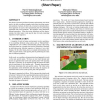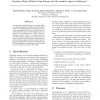682 search results - page 19 / 137 » Autonomous Environment and Task Adaptation for Robotic Agent... |
PPSN
2010
Springer
13 years 5 months ago
2010
Springer
This paper is concerned with a fixed-size population of autonomous agents facing unknown, possibly changing, environments. The motivation is to design an embodied evolutionary algo...
ATAL
2008
Springer
13 years 9 months ago
2008
Springer
For robots to become prevalent in human environments, the robots need to be able to perform complex tasks often involving sequential repetition of actions. In this work, we presen...
GECCO
2009
Springer
14 years 2 months ago
2009
Springer
Embodied cognition emphasizes that intelligent behavior results from the coupled dynamics between an agent’s body, brain and environment. In response to this, several projects h...
FGR
1996
IEEE
13 years 11 months ago
1996
IEEE
As autonomous robots become increasingly adept at performing simple tasks like moving from place to place and picking up and delivering objects, it is becoming apparent that an im...
AAAI
2011
12 years 7 months ago
2011
When mobile robots perform tasks in environments with humans, it seems appropriate for the robots to rely on such humans for help instead of dedicated human oracles or supervisors...


